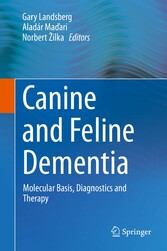Suchen und Finden
Preface
5
Canine Dementia: Unbearable Lightness of Ageing
5
Acknowledgements
7
Contents
10
1: Clinical Picture of Canine and Feline Cognitive Impairment
11
1.1 Clinical Signs of Cognitive Dysfunction
12
1.2 Prevalence of Behavior Signs in Senior Pets
14
1.3 Pet Owner Reporting
15
1.4 Diagnosis
16
1.5 Senior Cognition and Decline in Learning and Memory
18
1.6 Neuropsychological and Behavioral Assessment
18
1.7 Summary
19
References
20
2: Behavioural and Medical Differentials of Cognitive Decline and Dementia in Dogs and Cats
23
2.1 Differential Diagnosis of CDS
23
2.1.1 Behavioural Differentials of CDS in Dogs and Cats
23
2.1.1.1 Anxiety
24
2.1.1.2 Fear
25
2.1.1.3 Night-Time Waking
26
2.1.1.4 Excessive Vocalisation
27
2.1.1.5 House Soiling
27
2.1.1.6 Aggression
28
2.1.1.7 Repetitive Behaviours
29
2.1.2 Medical Differentials of CDS in Dogs and Cats
29
2.1.2.1 Sensory Decline
31
2.1.2.2 Pain
31
2.1.2.3 Cardiovascular Disease
31
2.1.2.4 Endocrine Disease
32
2.1.2.5 Gastrointestinal Disease
33
2.1.2.6 Urinary System Disease
33
2.1.3 Neurological Differentials of CDS in Dogs and Cats
34
2.2 Diagnostic Approach to Reach a Presumptive Diagnosis of CDS
34
2.2.1 Signalment
34
2.2.2 History Taking
34
2.2.2.1 Disorientation
35
2.2.2.2 Alterations in Interactions with Owners, Other Pets and the Environment
36
2.2.2.3 House Soiling
36
2.2.2.4 Changes in Activity
36
2.2.2.5 Establishment of the Most Relevant Complaint(s)
36
2.2.3 Patient Examination
37
2.2.3.1 Physical Examination
37
2.2.3.2 Orthopaedic Examination
37
2.2.3.3 Ophthalmological Examination
38
2.2.3.4 Neurological Examination
38
2.2.3.5 Changes on Neurological Examination that Would Not Be Expected with CDS
39
2.2.4 Problem List and Differential Diagnosis
40
2.2.4.1 Problem List
40
2.2.4.2 Differential List
41
2.2.4.3 Differential Diagnosis: DAMNITV
41
2.2.4.4 Degenerative Differentials
41
Ceroid Lipofuscinosis
41
L-2-Hydroxyglutaric Aciduria
42
Other Neurodegenerative Diseases
43
2.2.4.5 Anomalous: Brain Malformations
43
2.2.4.6 Metabolic Differentials
44
Hypoglycaemia
44
Hepatic Encephalopathy
45
Renal Encephalopathy
47
Electrolytes Disturbances
48
2.2.4.7 Nutritional
50
Vitamin B1 Deficiency
50
Vitamin E Deficiency
51
2.2.4.8 Neoplastic Brain Disease
51
2.2.4.9 Inflammatory Non-infectious Brain Disease
53
2.2.4.10 Infectious Brain Disease
55
2.2.4.11 Traumatic Differential: Chronic Repetitive Traumatic Brain Injury
56
2.2.4.12 Toxic Differential: Lead Poisoning
57
2.2.4.13 Vascular
58
Hypertensive Encephalopathy
58
Cerebrovascular Accidents
59
2.2.5 Diagnostic Testing
61
2.2.5.1 Laboratory Testing
61
2.2.5.2 Blood Pressure
62
2.2.5.3 Advanced Imaging
62
2.2.5.4 CSF Analysis
63
2.2.5.5 Additional Testing
63
2.2.6 Summary
65
References
66
3: Phenotypic Variability and Clinical Staging of Canine Dementia
69
3.1 The Clinical Picture of Canine Dementia in a Nutshell
70
3.1.1 Disorientation and Activity Changes
70
3.1.2 Changes in Social Interactions
70
3.1.3 Sleep and Wakefulness Cycle Changes
71
3.1.4 Changes in Hygiene Habits
71
3.2 Questionnaires: A Double-Edged Sword in the Diagnostics of CDS
71
3.3 CDS Clinical Staging
73
3.4 The Phenotypic Variability of CDS
75
3.5 Summary
76
References
76
4: The Aged Dog as a Natural Model of Alzheimer’s Disease Progression
79
4.1 Introduction
80
4.2 Alzheimer’s Disease
81
4.2.1 Neuropathological Features
81
4.2.2 Cognitive Decline
81
4.2.3 Pathophysiological Biomarkers of Progression
82
4.3 The Aged Dog Model of Alzheimer’s Disease Progression
83
4.3.1 Neuropathological Changes
83
4.3.2 Cognitive Decline
85
4.3.3 Pathophysiological Biomarkers
88
4.4 Predictive Validity of the Aged Dog Model
89
4.4.1 Symptomatic Treatment
90
4.4.2 Disease-Modifying Treatments
90
4.4.3 Non-pharmacological Studies
91
4.5 Summary
92
References
92
5: Brain Aging in the Dog
103
5.1 Introduction
103
5.2 Structural Brain Changes and Neuron Losses
104
5.3 Plaques and A? Accumulation
104
5.4 Vascular Neuropathology
106
5.5 Oxidative Damage and Mitochondrial Dysfunction
107
5.6 Inflammation
108
5.7 White Matter Pathology
108
5.8 Summary
108
References
109
6: Neuropathology of Feline Dementia
113
6.1 Introduction
113
6.2 Structural Brain Changes and Neuron Losses
114
6.3 A? Accumulation
115
6.4 Tau Pathology
116
6.5 Neurotransmitter Systems
118
6.6 Vascular Pathology
118
6.7 Summary
119
References
119
7: Proteomic Approaches for Diagnostics of Canine and Feline Dementia
122
7.1 Tissue Types for Biomarker Identification and Quantification
122
7.1.1 Cerebrospinal Fluid
123
7.1.2 Blood (Plasma and Serum)
123
7.1.3 Urine, Saliva, and Tears
124
7.2 Biomarker Quantification Methods Used in Diagnostics
124
7.2.1 Immunoassays
124
7.2.2 Multiplex and High-Sensitivity Immunoassays
125
7.3 Proteomic Approaches in Biomarker Discovery
127
7.3.1 Proteome Fractionation Techniques
128
7.3.2 Mass Spectrometry
129
7.4 Summary
131
References
131
8: Current Pharmacological and Non-pharmacological Approaches for Therapy of Feline and Canine Dementia
137
8.1 Treatment of CDS
138
8.2 Pharmacological Therapy
138
8.2.1 Selegiline
139
8.3 Propentofylline
139
8.4 Cholinergic Decline
140
8.5 Natural Supplements
140
8.6 Nutritional Intervention
141
8.7 New Horizons
143
8.7.1 Adjunctive Therapy
144
8.8 Drug Doses
145
8.8.1 Behavioral and Environmental Management
145
8.9 Considerations for Senior Pet Enrichment
146
8.10 Feline
146
References
147
Additional Resources
151
9: Preventive and Risk Factors of Canine Dementia
152
9.1 Canine Dementia Is an Age-Related Disorder of the Brain
153
9.2 Diet as Protective and Risk Factor for CDS
154
9.3 Dog Size as a Risk Factor for CDS
154
9.4 The Influence of Environment on Canine Cognitive Status
155
9.5 Other Risk Factors for CDS
156
9.6 Protective Factors
157
9.7 Summary
158
References
159
Cognitive Dysfunction Syndrome: Information for Pet Owners
162
Alle Preise verstehen sich inklusive der gesetzlichen MwSt.








